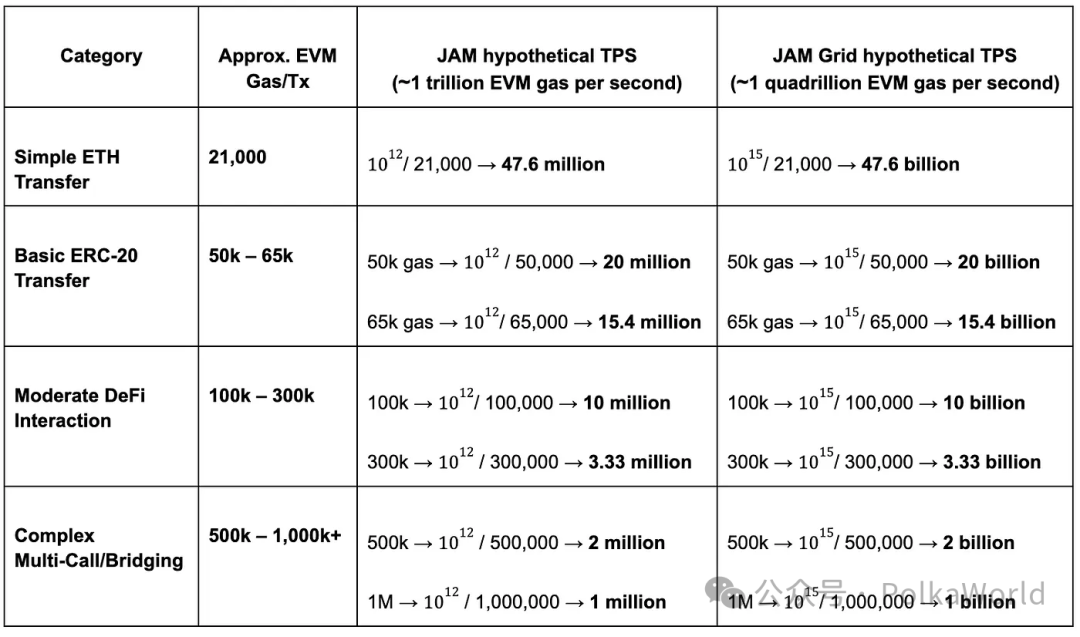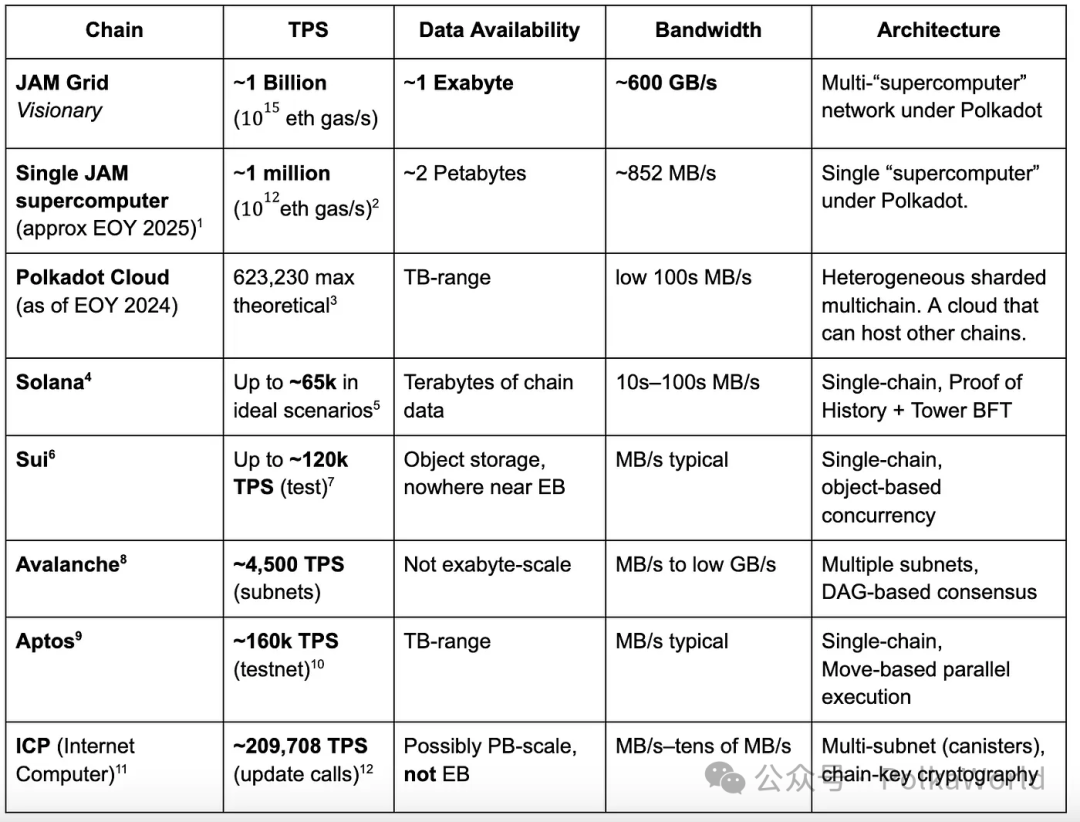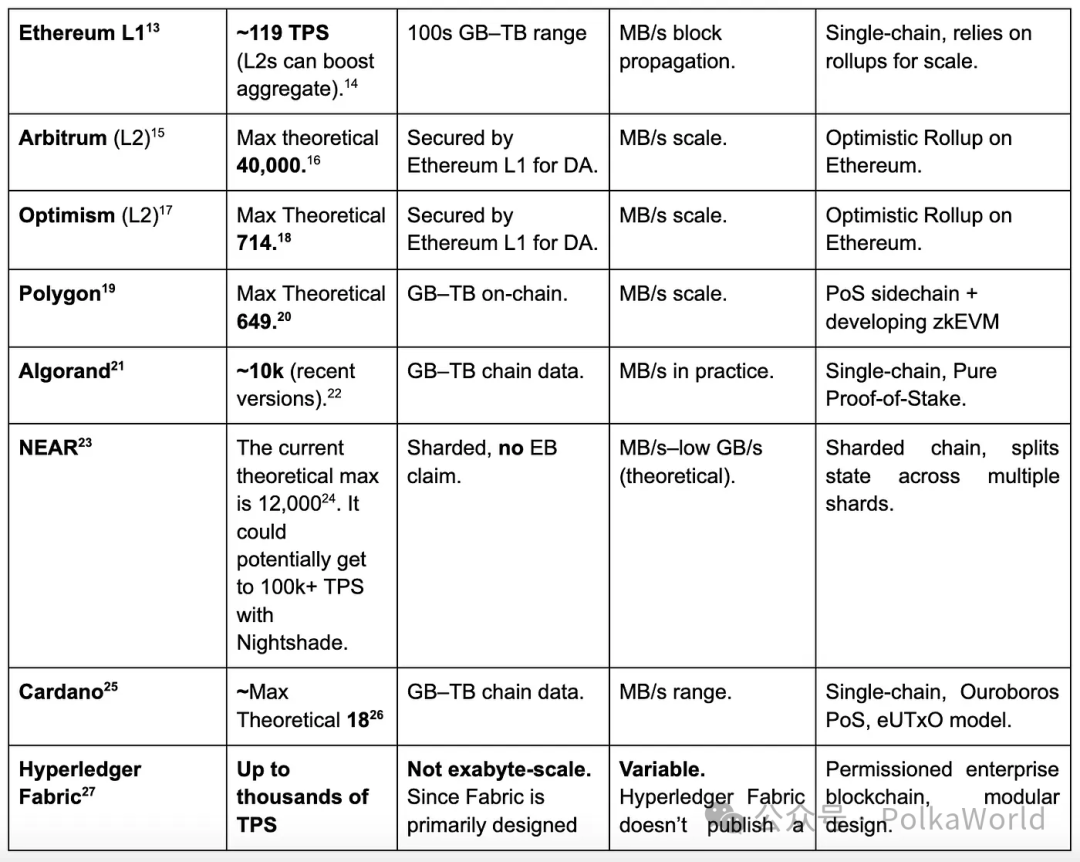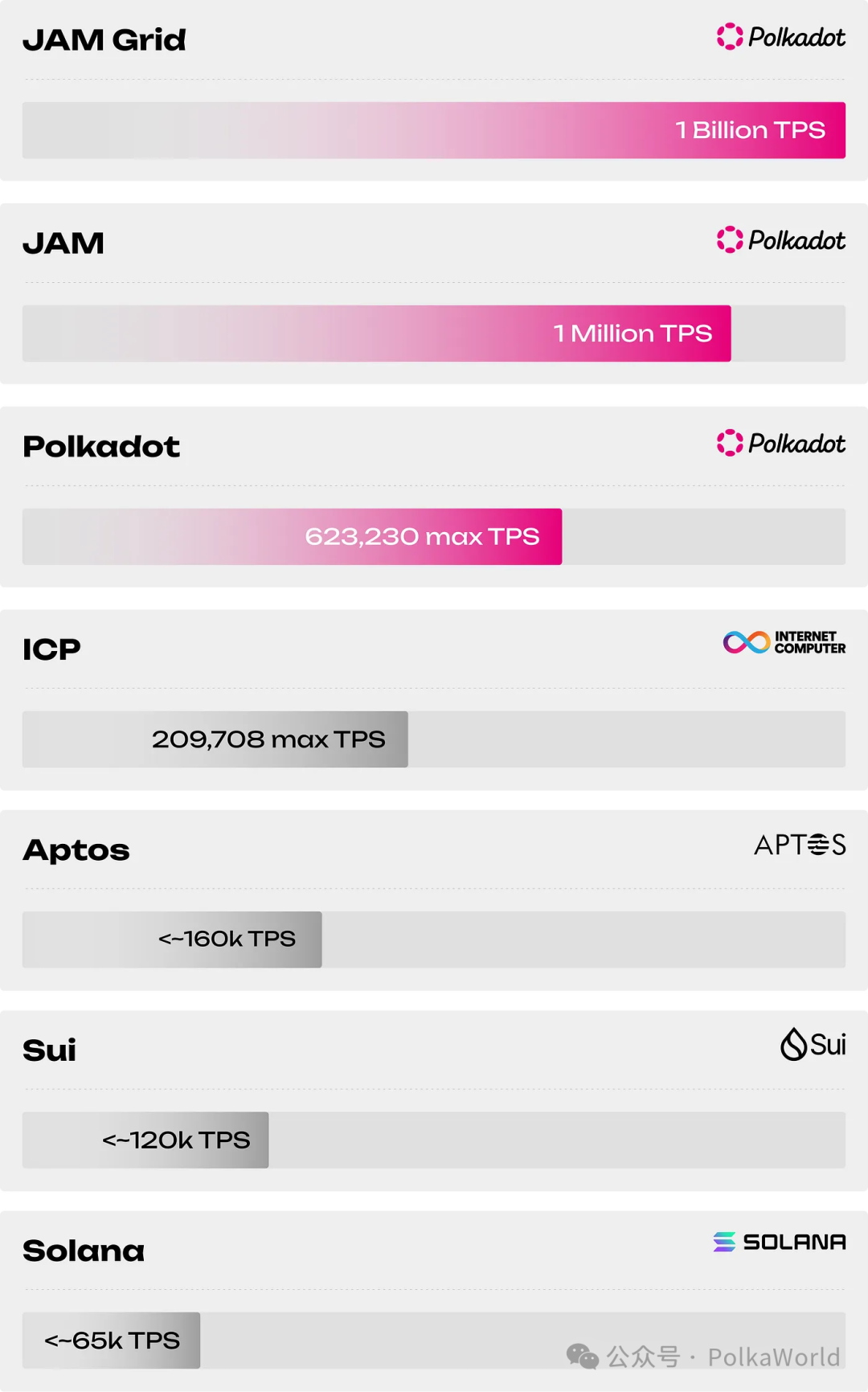
Original text: Permanence DAO, PolkaWorld
Polkadot aims to become a true Web3 cloud (Polkadot Cloud), providing the infrastructure for building highly scalable and extremely reliable Web3 applications and services. While different, this is similar to what AWS does for Web2 applications and services.
Want to know how JAM and JAM Grid drive Polkadot to become a true Web3 cloud? Check out this article to learn what JAM and JAM Grid are!
JAM: Unprecedented scale and computing power
JAM Grid: Unlocking 1 billion TPS
Comparison chart with other blockchains
What applications can JAM enable?
What applications can JAM Grid enable?
How JAM Grid empowers developers
How DOT drives JAM Grid
Conclusion
Additionally, Dr. Gavin Wood will hold a JAM Tour lecture series in six cities in China from late February to early March, sharing what JAM is, what problems JAM solves, and what developers can do based on JAM at local university centers! You will have the opportunity to meet Gavin Wood in person and discuss cutting-edge technologies and concepts in Web3! Hurry up and register here! “JAM Tour China Station Registration Open! Meet Dr. Gavin Wood in 2025!”
Before we officially begin, let's take a brief look at the timeline of Polkadot Cloud:
Polkadot Cloud — Genesis Phase: May 2020
Polkadot went live at this time, producing the first block, marking the official "launch" of Polkadot Cloud.
Polkadot Cloud — First Milestone (Parachains), November 2021
This marks the birth of the first cloud service of Polkadot Cloud. This service allows developers to build custom blockchains and connect them to Polkadot Cloud, achieving shared security.
First Cloud Service Deployment — Second Milestone, December 2021
The first cloud service (parachains) went live, and different teams began using it to deploy their parachains.
Polkadot Cloud — Third Milestone (JAM), TBD, possibly before the end of 2025
JAM (Join-Accumulate Machine) is a trustless supercomputer that forms the foundation of the Web3 cloud.
Polkadot Cloud — Potential Fourth Milestone (JAM Grid), TBD
JAM Grid will be a hypothetical interconnected supercomputer cluster, with each computer running the JAM protocol.
Today's blockchains, even so-called "high-performance" blockchains, struggle to handle real-time, data-intensive workloads. In contrast, JAM Grid theoretically can achieve 1 billion transactions per second (TPS), exabyte-scale storage, and hundreds of GB/s bandwidth, potentially providing Web3 services with capabilities comparable to modern cloud data centers.
Introduction to JAM and JAM Grid
JAM is a single supercomputer that enables the construction of scalable and reliable Web3 applications and services. The main goal of JAM is to provide a flexible and efficient framework for managing data and computation in the network. It aims to simplify data integration and maintenance while ensuring the integrity and security of the network. You can learn more about JAM through Gavin Wood's gray paper (https://graypaper.com/) or PolkaWorld's articles.
Gavin Wood: JAM is a trustless supercomputer that forms the foundation of the Web3 cloud!
Breaking! Gavin announces the JAM service roadmap! JAM Asia tour next year!
JAM Tour China Station Registration Open! Meet Dr. Gavin Wood in 2025!

A new concept — JAM Grid, proposes the next leap: a network of multiple supercomputers that can theoretically achieve 1 billion transactions per second (TPS), exabyte-level data availability, and high-performance computing (HPC) level bandwidth.
Regarding the TPS metric, it is worth noting that in Gavin Wood's year-end summary article, he mentioned that the computing power could reach 10 quadrillion EVM equivalent gas per second. Due to the vast differences in gas consumption among different transactions, there is no universally applicable "transactions per second" (TPS) metric. For example, on Ethereum, a simple ETH transfer may require 21,000 gas, while more complex smart contract interactions may require hundreds of thousands or even millions of gas. Below is a comparison table (note that these figures are approximate).

The above chart shows that for gas-intensive transactions, JAM's upper limit is about 1 million TPS, while JAM Grid's upper limit is about 1 billion TPS. However, it is important to note that these figures are approximate.
JAM: Unprecedented Scale and Computing Power
What is JAM?
JAM (Join-Accumulate Machine) is a trustless supercomputer that forms the foundation of the Web3 cloud. It is a new computing model and protocol designed to enhance Polkadot's capabilities and address scalability challenges in blockchain technology. JAM will support 1 million transactions per second (TPS), 2 PB of data availability, and 857 MB/s of bandwidth.
Why is it important?
JAM is the next upgrade that will bring Polkadot closer to its original vision — to become a permissionless global supercomputer.
How does it compare to other blockchains?
JAM's scalability is designed to support large-scale real-time applications that traditional blockchains cannot handle.
JAM Grid: Unlocking 1 Billion TPS
What is JAM Grid?
JAM Grid is a hypothetical interconnected supercomputer cluster, with each computer running the JAM protocol, promising to achieve 1 billion transactions per second (TPS), 1 exabyte of data storage, and 600 GB/s of bandwidth.
Why is it important?
These numbers far exceed today's blockchain standards, heralding a scale similar to high-performance computing (HPC). If realized, it would be capable of handling globally scaled applications while maintaining decentralized security.
How does it compare to other blockchains?
Projects like Solana, Aptos, Sui, and Avalanche have pushed for higher throughput than traditional blockchains, but still have not reached exabyte-level storage or high-performance computing (HPC) level bandwidth.
Comparison Chart with Other Blockchains
TPS (Transactions Per Second): Measures raw throughput — how many transactions a blockchain can process per second. Higher TPS typically means more scalable decentralized applications (dApps) and a better user experience.
Data Availability: The ability of a blockchain network to store and manage data on-chain. It includes the total amount of data and its accessibility across all network nodes. Strong data availability ensures consistent access and verification of transaction records, application states, and user data while maintaining the integrity, security, and decentralization of the blockchain.
Bandwidth: Reflects network capacity — the speed at which data is transmitted within the system. High bandwidth is crucial for blockchains designed to handle large volumes of transactions (and related data) to prevent bottlenecks.
Architecture: Highlights design approaches — such as the difference between single-chain and sharded or subnet architectures. Architecture affects TPS and the ease of scaling and evolving the blockchain.
Now that we understand why these metrics are important, let's see how the vision of JAM Grid compares to other leading projects.
It is important to note that many TPS figures are from testnets or theoretical maximums — actual performance may vary. The metrics for data availability and bandwidth are also ranges/approximations, as there are no precise numbers. We strive to present a fair and accurate comparison, but if you find inconsistencies, please contact us for corrections.


You can find a Google document containing charts and footnotes here.
Again, the metrics in the charts above are ranges/approximations. If more accurate numbers become available, feel free to contact us.
Key Points
Exabyte Storage and HPC Bandwidth: JAM Grid envisions providing 1 exabyte of data storage and 600 GB/s throughput — comparable to large data centers, rather than typical blockchains.
Comparison with Current Networks: While blockchains like Solana, Avalanche, and Aptos have surpassed older platforms in TPS, they fall short of HPC-level data availability or sustained bandwidth.
Multiple "Supercomputer" Model: There will be multiple supercomputers, each running the JAM protocol. This will create a network where all supercomputers can communicate with each other and potentially share resources. How these supercomputers communicate will be a key challenge.


What Applications Can JAM Enable?
With approximately 1 million TPS, 2 PB of data availability, and 857 MB/s bandwidth, the JAM supercomputer brings a significant leap beyond most existing blockchains. Here are some examples of applications that JAM can unlock:
Real-time Gaming and Virtual Worlds (City or National Level)
Why is it not possible now? Current blockchains cannot handle the frequent state changes of thousands (let alone millions) of players.
How does JAM help? 1 million TPS means that fast interactions in city-level or national-level virtual worlds can be maintained on-chain, reducing reliance on centralized servers.
Real-time IoT and Automation (Enterprise or City Level)
Why is it not possible now? IoT devices generate millions of events per second in city or industrial deployments. Most blockchains cannot handle such a high volume of on-chain events, leading to severe congestion.
How does JAM help? Approximately 1 million TPS throughput combined with PB-level data availability means each device can reliably publish millions of events per second on-chain, making it ideal for large enterprises or smart cities. Hundreds of MB/s of bandwidth ensure rapid synchronization of sensor data between global nodes — sufficient for city or enterprise-level needs, but not covering all IoT devices worldwide.
High-traffic Stablecoin or Payment Systems (National Level)
Why is it not possible now? Traditional blockchains face network congestion and high fees under heavy loads, limiting the mainstream application of on-chain micropayments.
What can JAM provide? Approximately 1 million TPS capacity (assuming simple transactions) allows stablecoin or payment networks to serve national or regional economies. Fast throughput keeps fees low and transaction confirmations swift. While it may not enable billions of micropayments globally every day, it is sufficient to surpass the limitations of most existing L1s.
Once JAM is realized, Polkadot Cloud will significantly exceed many existing L1s in throughput, storage, and bandwidth, capable of supporting real-time, data-intensive dApps that are currently unfeasible on existing blockchains.
What Applications Can JAM Grid Enable?
Today's blockchains — even "fast" ones — struggle to handle real-time, large-volume workloads. In contrast, JAM Grid, supporting billions of TPS, exabyte-level storage, and hundreds of GB/s bandwidth, can provide performance on par with modern cloud data centers for Web3 services. Here are some examples of applications that may ultimately become a reality under these conditions:
Large-scale Multiplayer Virtual Worlds and Games
Why is it not possible now? Current blockchains cannot handle real-time updates for millions of concurrent players, let alone store vast amounts of game assets, states, and logs on-chain.
How does JAM Grid help? With billions of TPS and massive bandwidth, JAM Grid can handle frequent state updates (such as player actions and world changes), keeping all data on-chain, thus eliminating reliance on centralized game servers. Exabyte-level storage allows for a vast library of 3D assets, character inventories, and item histories to remain verifiable and persistent.
Real-time IoT and Automation
Why is it not possible now? IoT devices continuously generate data streams — such as temperature, vehicle telemetry, and sensor updates — potentially producing millions of events per second. No mainstream blockchain can process and verify such massive amounts of data in near real-time.
How does JAM Grid help? High throughput and scalable data availability allow each device to record updates directly on-chain without overwhelming the network. High bandwidth ensures data can be rapidly disseminated among globally distributed nodes.
Global-scale Social Networks
Why is it not possible now? Social platforms generate billions of interactions daily (such as likes, posts, comments, messages), requiring massive throughput and storage. Existing blockchains cannot handle such a vast volume of on-chain activity.
How does JAM Grid help? Billions of TPS can support near-instantaneous publishing, while exabyte-level storage can preserve rich media and user histories without relying on off-chain solutions. Built-in decentralization ensures no single company controls user data or content moderation.
Decentralized AI and Large-scale Machine Learning
Why is it not possible now? Training and inference of large AI models require significant computational power and massive datasets, typically handled by centralized high-performance computing (HPC) clusters.
How does JAM Grid help? JAM Grid's HPC-like throughput and bandwidth can host distributed AI workloads on-chain, ensuring data auditability, verifiability of training results, and equal access to HPC resources for all.
Global Stablecoin Payment Systems
Why is it not possible now? Traditional stablecoins already face congestion and high fees on L1 blockchains under heavy loads. Billions of daily micropayments (such as IoT microtransactions and everyday purchases) become unfeasible.
How does JAM Grid help? High throughput + fast confirmations allow stablecoins to scale globally without astronomical fees or bottlenecks. This lays the foundation for a ubiquitous and low-cost payment system, more open than any corporate provider.
In summary, JAM's extreme throughput and storage capabilities unlock new Web3 services that rival traditional cloud solutions in performance while maintaining decentralized ownership.
How Does JAM Grid Empower Developers?
In the previous section, we showcased examples of global-scale applications that JAM Grid can support, and developers may wonder: how does this open new doors for me? Here are some ways JAM Grid changes the development experience, not just unlocking theoretical workloads:
Large-scale On-chain Data Processing
Today's Bottleneck: Even "fast" L1s and many L2s impose strict limits on data or state, forcing developers to rely heavily on off-chain servers, IPFS, or private storage. This complicates architecture, increases trust assumptions, and limits transparency.
JAM Grid's Breakthrough: With exabyte-level data availability, developers can design truly data-intensive decentralized applications (dApps) where logic and large datasets are stored on-chain. This ensures auditability and composability without relying on off-chain databases.
Easier Implementation of Global Applications
Today's Bottleneck: Even successful Web3 projects often encounter performance bottlenecks, and when fees spike or throughput drops, mainstream users feel alienated.
JAM Grid's Breakthrough: Supporting billions of TPS, developers can target mass market adoption — like truly mainstream social applications or multinational supply chain solutions — without crashing the system due to excessive load.
JAM Grid is not just about supporting large, eye-catching use cases; it also significantly reduces the friction between innovative ideas and efficient, trustless solutions. Imagine you have spent years hitting walls with scaling issues or piecing together partial solutions; in this case, JAM Grid's HPC-level design opens up a future for developers where they can fully rely on on-chain, horizontally scalable solutions while still depending on a shared security layer.
It can be seen as the "cloud moment" for Web3 development: you write code, you deploy applications, and the network (through the security layer HPC supported by Polkadot DOT) ensures performance and security — all while maintaining the core decentralized ethos of blockchain.
How Does DOT Drive JAM Grid?
DOT is the key to securing the entire Polkadot ecosystem — from Polkadot Cloud to every JAM supercomputer within JAM Grid.
Ensuring Security Through Staking
To ensure the security of the Polkadot network — and thereby the security of JAM Grid — validators need to stake DOT. As JAM Grid scales, the amount of staking required will also increase, potentially enhancing the role of DOT in securing these supercomputers.
Access and Participation
To build or deploy services on JAM-based supercomputers, users and developers will interact with Polkadot's infrastructure, paying fees or staking DOT. Essentially, DOT becomes the passport to access the world's most powerful supercomputers (or supercomputer grid) for Web3 development.
Economic Alignment
If JAM Grid successfully develops, it will enhance the utility of Polkadot, further driving demand for DOT — creating a positive feedback loop between the growth of supercomputers and the fundamental value of DOT.
By making DOT the asset that secures, accesses, and drives JAM Grid, DOT becomes the core economic driver of a globally scaled Web3 cloud. This synergy makes DOT no longer just "another token" — it becomes the foundation for hosting and running the next generation of decentralized high-performance applications.
Conclusion
If JAM Grid can truly achieve 1 billion TPS and exabyte-level storage, it will prove that there is indeed a way to build decentralized infrastructure capable of handling global-scale demands. Rather than fostering zero-sum competition, this vision emphasizes a common driving force — establishing a "supercomputer" governed by the community rather than tech giants, which is permissionless and globally accessible.
These ambitious specifications are a guide to a true Web3 native "cloud": globally accessible, economically incentivized, and free from centralized control. If JAM Grid succeeds, it will not only raise the standards of Polkadot — it will also inspire a broader ecosystem to envision new possibilities for high-throughput, trustless computing. The ultimate goal is to enable billions of people to benefit from transparent, censorship-resistant services.
免责声明:本文章仅代表作者个人观点,不代表本平台的立场和观点。本文章仅供信息分享,不构成对任何人的任何投资建议。用户与作者之间的任何争议,与本平台无关。如网页中刊载的文章或图片涉及侵权,请提供相关的权利证明和身份证明发送邮件到support@aicoin.com,本平台相关工作人员将会进行核查。



